AQUAMANIA (Disney) Wolfgang Reitherman [View]
BEEP PREPARED (Warner Bros.) Chuck Jones [View]
NELLY’S FOLLY (Warner Bros.) Chuck Jones [View]
THE PIED PIPER OF GUADALUPE (Warner Bros.) Friz Freleng [View]
And the Oscar went to:
ERSATZ (Zagreb) Dusan Vukotic, director. [View]
I have no doubt the Academy’s Shorts branch picked what they thought were the best Hollywood studio cartoon shorts – along with one superior foreign short – from a very weak batch of submissions (see below). Zagreb had emerged. Hollywood was not completely defeated – but the POV of the committee members had changed. The Academy was now cut loose from its Hollywood masters (at least as far as the cartoon short committee was concerned), and the artists have won. Creativity, aesthetics, ingenuity would trump simply awarding a beloved local studio or a popular character. There was no turning back. Ersatz would be the first of dozens of foreign winners to come – with no Hollywood strings attached.
You can watch Glynis Johns and George Hamilton present the award for Ersatz to Zagreb executive Vlado Teresak, here:
However – submitted, screened, but NOT nominated were:
 ABNER THE BASEBALL (Paramount) Seymour Kneitel
ABNER THE BASEBALL (Paramount) Seymour Kneitel
CATCH MEOW (Columbia) William Hanna and Joseph Barbera
DRUM ROLL (Terrytoons) David Tendlar
HAWAIIAN GUY (UPA) Steve Clark
THE LION AND ALBERT (Continental) Robert Fenwick
RIDING HOOD MAGOO (UPA) Grant Simmons
SLEEPING BEAUTY (Jay Ward) William Hurtz
SNIDLEY’S MONSTER (Jay Ward) Pete Burness (?)
THE TOM AND JERRY CARTOON KIT (MGM) Gene Deitch
TREE SPREE (Terrytoon) Art Bartsch
Here’s the documentation:

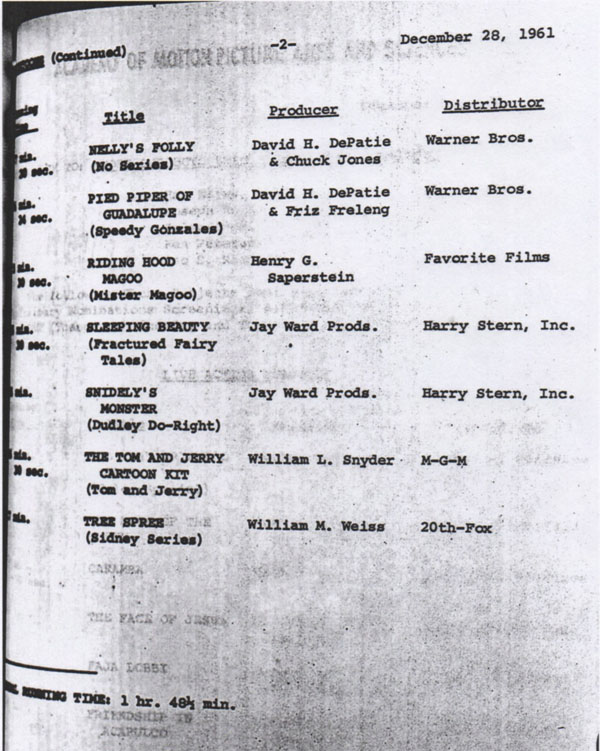
And so we continue our research into what other cartoons were submitted to the Academy for Oscar consideration but failed to make the cut.
Hoo-boy! I think this may be the sorriest set of submissions from any year – then again, who knows what next year will bring? Theatricals that might as well have been TV cartoons – Loopy DeLoop, Silly Sidney, a Deitch Tom & Jerry, Hector Heathcote, Abner The Baseball – and a set of actual made-for-television material – including Dudley Do-Right, a TV Magoo, a Fractured Fairy Tale and a Dick Tracy cartoon. Regular attendees like Ward Kimball, Jules Engel and Chuck Jones must have pulled their hair out. The rule against nominating TV productions didn’t exist before 1972 (the year Richard Williams TV Special A Christmas Carol won). It’s hard to believe that rule wasn’t drafted on January 11th, 1962 (the day after these screenings).
With these posts we ask that you put yourself in their place – which films would you have nominated? Which cartoon should have won? For your edification and viewing pleasure, here are the cartoons that didn’t make the cut. Enjoy the show (and don’t say I didn’t warn you)!
ABNER THE BASEBALL (Paramount) Seymour Kneitel
The biggest addition to the pared-down crew at New York’s Paramount Animation Studio was the addition of comedian, voice man and writer Eddie Lawrence. Apparently Lawrence’s Old Philosopher monologue was a huge hit with Seymour Kneitel (Full Disclosure: I too am a big fan of Eddie Lawrence). Lawrence began showing up in the Paramount cartoons last season and was a natural fit.
Kneitel invited Lawrence to contribute stories and write scripts, adapting several of his comedy routines and vocal characterizations to animation. Two characters he had developed on his comedy records were “Percy” and “Ralph” (two years later these characters would become known as Swifty and Shorty). Kneitel’s biggest coup at this time was getting Paramount to buy the screen rights to Lawrence’s 1958 recording Abner The Baseball – and adapting it (via Irv Spector) to a double length cartoon “special”.
As a recoding, it’s hilarious – and very topical (and perhaps now a bit ‘dated’). When you listen, you can’t help but be amused at Lawrence’s New Yorker voice characterization, and visualizing in your mind how crazy this is – getting into the mind of a baseball. As a film, it falls flat. Nothing much was done to “open up” this material. You are just watching an illustrated version of the monologue. Unfortunately, it probably bored the Academy’s nominating committee to tears.
CATCH MEOW (Columbia) William Hanna and Joseph Barbera
Once again, Loopy DeLoop tries to prove he’s not a bad guy – this time by attempting to negotiate peace between a cat and a mouse. Loopy gets clubbed with a pot and a bat, hit with a rock and – by way of a prop all bonafide cartoon cats and mice must carry – is blown-up with a stick of dynamite. Eventually, on their own the cat and mouse try being friends – and after a week get bored with this so-called “friendship”. So Loopy, once again, comes to their aid by making them enemies again. There – saved you six minutes. Tony Bendict contributes a few witty lines – but visually there is nothing here. Not Nominated.
DRUM ROLL (Terrytoons) Dave Tendlar
Hector Heathcote – described here as “a clumsy, awkward patriot” – is the anxious drummer of an Army company trying to spy on the enemy camp. The commander gets an idea to hide the accident-prone Heathcote inside his drum and roll it (hence the title), Trojan Horse style, behind enemy lines and into the Redcoat’s fort. Hilarity ensues… NOT! I actually like these Hector Heathcote cartoons… but, as the cliche goes: if you’ve seen one, you’ve seen them all.
HAWAIIAN GUY (UPA) Steve Clark
Okay, I confess – These Dick Tracy cartoons are a guilty pleasure of mine. I grew up watching these and have many fond memories of them. That said… I can’t believe UPA submitted one of these to the Academy. Oh, how the mighty had fallen. UPA was now just a shadow of where it had been five short years ago.
On the plus side, Everett Sloan (of Welles’ Mercury Theatre) voices Dick Tracy, “Uncle Johnny” Coons is Stooge Villa and Benny Rubin voices Joe Jitsu, an unfortunate stereotype among Tracy’s diverse police force (which included British bobby Hemlock Holmes (a dog!), Hispanic detective Go Go Gomez and the overweight Irish cop Heap O’Calorie). Joe flies out to Hawaii to follow up on a report of two crooks who attempted to steal the jewel off Diamond Head. He uses his skills of vocal impersonation to trick the bad guys. Click the title card below to watch the cartoon on You Tube – if you dare.
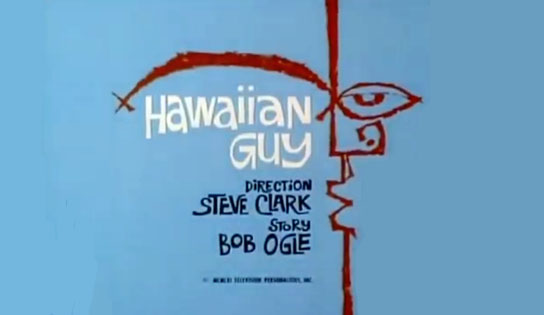
THE LION AND ALBERT (Continental) Robert Fenwick
Another submitted cartoon that has vanished off the face of the Earth (though I’m hoping a reader will either upload it or point us towards a viewing copy). The New York Times posted this blurb about the short on April 2nd, 1961 which gives much of the details:
“Tomorrow a one-reel cartoon titled “The Lion and Albert” will have its local premiere at the Baronet Theatre, as a supplementary attraction to “Saturday Night and Sunday Morning” and thereby hangs a small tale. “Lion” marks the invasion of the theatrical field of Milner-Fenwick, a Baltimore organization that has been producing documentary and industrial short subjects.
Produced and directed by Bob Fenwick with Erwin Milner serving as executive producer, the cartoon is narrated by none other than Sterling Holloway, long identified with those comic monologues in colloquial British dialect. “Lion combines twp episodes by author Marriott Edgar about Ramsbottom family, namely “The Lion and Albert” and “The Return of Albert”. Mr. Holloway recorded the narration while doing his stage stint here as the chimney sweep, Dolittle, in “My Fair Lady”. There will be more Ramsbotton cartoons, Mr. Milner reveals, among them being “With ‘er ‘ead Tucked Underneath ‘er Arm” and “The Runnymede Fairy”, with Mr. Holloway again doing the narration”
For more information about Milner-Fenwick and this film, click here.
RIDING HOOD MAGOO (UPA) Grant Simmons
As far as these TV Magoo’s go – this one is rather good. A stupid wolf (Mel Blanc) mistakes Magoo for Red Riding Hood. Magoo in a red graduation cap and gown, en route to his Rutgers college reunion, likewise mistakes the wolf for classmate “Harvey Goober”. Oscar worthy? No. But funny drawings, funny line readings, and perfectly watchable. Not sure I understand the two sets of credits, but both George Atkins and Tony Benedict get story nods.
SLEEPING BEAUTY Bill Hurtz
I actually show this in my animation history classes as a prime example of a Jay Ward Fractured Fairy Tale. It still gets laughs because the prince resembles Walt Disney and the parody of Disneyland and Disney merchandising hasn’t dated at all – in fact its more relevant than ever. Of course Daws Butler, June Foray and Edward Everett Horton are terrific here as well. Educated guess says Pete Burness directed this one. I’m sure the Academy’s Shorts committee gave it a few chuckles – but no nomination.
SNIDLEY’S MONSTER (Jay Ward)
Submitted under the title “Snidely’s Monster” I’ve deduced that the cartoon screened must have been the Dudley Do-Right episode “Recruiting Campaign” – for obvious reasons. Dudley is charged with recruiting new mounties and evil Snidley Whiplash has just created a monster named “Finster” to infiltrate the Mountie headquarters. Soon enough, Dudley recruits Finster which leads to Whiplash taking over the fort. A fight to the finish between Dudley and Finster resolves everything. Again, I’m sure the Academy appreciated the references to Pearl White, Colin Clive and Sabu – but why was this submitted? There were no rules against submitting television animation at this time, so why not?
THE TOM AND JERRY CARTOON KIT (MGM) Gene Deitch
Inspired by Bob Godfrey’s The Do-It-Yourself Cartoon Kit (1961), this is as close to actual meta-satire the Tom & Jerry cartoons ever got. Director Deitch and writer Chris Jenkyns (who was also freelancing for Jay Ward at the time) introduce us (via narrator Allen Swift) to the the kit containing all you need for “quiet, sophisticated humor” – including coffee and cigarettes for the animator. The kit doesn’t contain any backgrounds or settings so all the action is set against white space or color cards. The whole thing is sort-of a tour-de-force for animator Vaclav Bedrich (or who ever animated under him). Can you imagine if a Jim Tyer had seven minutes of dialogue free animation of two characters fighting each other against a blank backdrop? If MGM was going to submit one of the Deitch cartoons to the Academy – this was the one to submit. It was probably the best of the bunch (It’s my favorite anyway), because it differed from the norm. Imagine if the producers had submitted Dicky Moe? At least the animators in the Shorts branch probably got a kick out of the first minute or two.
TREE SPREE (Terrytoon) Art Bartsch
Minding his own business in the jungle, Sidney encounters an Indian “lumber man” who enslaves the naive elephant, forces him to chop trees and carry them to a sluice. Unfortunately everything Sidney does backfires and ends up trampling, crushing or slicing his slave driver. Not the worst Sidney I’ve seen… but nothing to be proud of. The Academy politely rejected this film too.
The earlier posts in this series: 1948, 1951, 1952, 1953, 1954, 1955, 1956, 1957, 1958, 1959 and 1960.
(Thanks to Libby Wertin, Keith Scott, Mike Kazaleh and Devon Baxter for special contributions to this post)



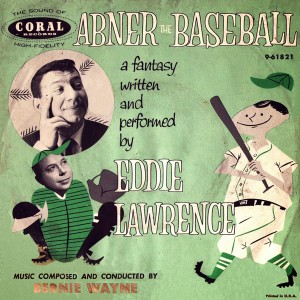
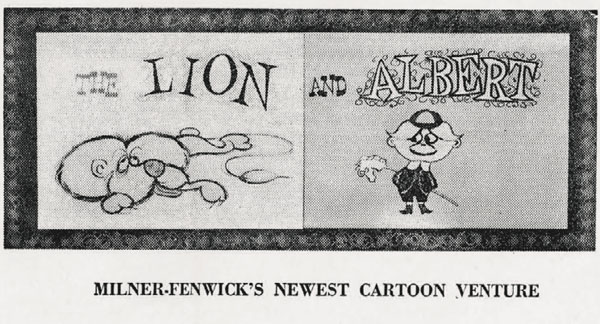
 Jerry Beck is a writer, animation producer, college professor and author of more than 15 books on animation history. He is a former studio exec with Nickelodeon Movies and Disney, and has written for The Hollywood Reporter and Variety. He has curated cartoons for DVD and Blu-ray compilations and has lent his expertise to dozens of bonus documentaries and audio commentaries on such. Beck is currently on the faculty of CalArts in Valencia, UCLA in Westwood and Woodbury University in Burbank – teaching animation history. More about Jerry Beck [
Jerry Beck is a writer, animation producer, college professor and author of more than 15 books on animation history. He is a former studio exec with Nickelodeon Movies and Disney, and has written for The Hollywood Reporter and Variety. He has curated cartoons for DVD and Blu-ray compilations and has lent his expertise to dozens of bonus documentaries and audio commentaries on such. Beck is currently on the faculty of CalArts in Valencia, UCLA in Westwood and Woodbury University in Burbank – teaching animation history. More about Jerry Beck [



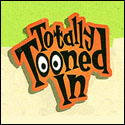



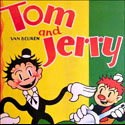
I guess that Hawaiian Guy, Sleeping Beauty and Shirley’s Monster weren’t nominated for the Oscar for Best Animated Short of 1961 because they were originally released for television (The Dick Tracy Show, Rocky and Bullwinkle and The Dudley Do-Right Show).
The Tom and Jerry Cartoon Kit should have been nominated for the Best Animated Short. This was the best, craziest and funniest Tom and Jerry cartoons during the Gene Dietch era. Love the chaotic judo showdown and the announcer telling that the “next film is for the kiddies” – which would show them how to make a poison gas.
Under the Academy rules for 1961, it appears that made-for-television cartoons were eligible as long as they also had a three-day theatrical run in Los Angeles County in the same year.
“Entertainment Short Subjects … distributed by a recognized distributing organization on a rental basis to 35mm theatres for the profit of the producer and distributor, anywhere in Los Angeles County for a definite first paid play date of three consecutive days after an opening prior to midnight, December 31, 1961, shall be eligible for consideration for the Awards.
“Pictures which qualify under the above rule, but which have also been exhibited in another medium are not to be excluded from eligibility, provided their first exhibition in another medium has occurred during the same Awards year.”
https://digitalcollections.oscars.org/digital/collection/p15759coll9/id/2431/rec/34
“…the cartoon is narrated by none other than Sterling Holloway, long identified with those comic monologues in colloquial British dialect.”
I believe they mean Stanley Holloway, who played Alfred Doolittle in My Fair Lady, not Sterling Holloway, best known as the voice of Winnie the Pooh.
It’s easy to make that mistake. i saw the clip and Holloway credit above for the cartoon Jerry showed. Usually most of us are famioliar with Sterling rather than Stanley..
It appears that the Dudley Do-Right was aired first on TV under a different title and I am also suspicious of SLEEPING BEAUTY, but I wonder if a few other TV shorts actually were given brief theatrical runs before airing on the small screen. This may have helped them get around some of the questioning.
Later in the decade (1968), we get a “documentary short” that could have potentially been listed in the animated category since there was more than enough cartoon footage in it: Saul Bass’ WHY MAN CREATES was aired on CBS’s first 60 MINUTES episode in September before making it to theaters. However it too bypassed questioning because it wasn’t aired “complete” and some could label that airing as a TV promo instead. I know… different situation. No comparison! Yet my main point is that there is always SOME wiggle-room they can get around.
Favorite Looney Tunes cartoons of 1961:
-Zip n Snort
-D’Fightin’ Ones
-The Abominable Snow Rabbit
-A Scent of the Matterhorn
-Compressed Hare
-The Last Hungry Cat
Would’ve been happy with any of those being nominated.
Guilty pleasures?
-Cannery Woe
-Daffy’s Inn Trouble
-What’s My Lion?
Any of your choices above are worthy of at least a “nod”. You would think the Hitchcock parody THE LAST HUNGRY CAT would have wowed them even more than BIRDS ANONYMOUS, but I guess it spoofed the television show too much and not his… movies.
Count me in with DAFFY’S INN TROUBLE as a guilty pleasure. I never viewed it as a “great” film; I would rate it (maybe) two and a half stars from a production stand point. Yet it really is so much fun to watch. Daffy doing his hee-haw after the boulder hits the wrong Inn gets me every time. It is obvious that the McKimson unit realized there would be no more big prizes after TABASCO ROAD and merely enjoyed themselves as best they could. Maybe because the McKimson films didn’t take themselves as seriously as Jones & Maltese’ “High Art” and Freleng’s “don’t fix what isn’t broken with the Tweety series”, they are like those fun B-movies you still enjoy.
I think I liked SIDNEY THE ELEPHANT better when he was voiced as an Ed Wynn caricature, and I say that only so that Sidney and his tormentor in this short could have somewhat differing voices.
I, too, found it laughable that the FRACTURED FAIRY TALE submission was made at all, especially since this one poked merciless fun at the Disney monopoly. I rather like “NELLIE’S FOLLY” simply because it is unusual. Throughout the decades, the one shot cartoons from Warner Brothers were always interesting, although the MAGOO entry here was a lot of fun.
I’m not much for LOOPY DELOOP, but this might have been a slight bit funnier if the cat and mouse did not have voices at all, and how odd that this is about a cat and mouse who, upon being forced to “be friends”, find out that it is actually more fun to be enemies; kinda says something about those Hanna-Barbera cartoons (the later TV incarnation) in which Tom and Jerry ultimately were pals!
Watching that clip of the Academy ceremony, I find it interesting that Chuck Jones and Friz Freleng were listed as “producers” for their respective films, rather than David H. DePatie, who was the general manager of the animation department. Did they change the rules (at least at Warner’s) by then?
Their producer titles seem to have been honorary, seeing as how by this point, they both had such active roles in the Looney Tunes output, including The Bugs Bunny Show airing on ABC that year.
Would have loved to have seen the faces on the Academy members as they sat watching Dickie Moe, lol….
Sleeping Beauty is my favorite Fractured Fairy Tale. It should have gotten an Emmy.
“They just don’t make trusty broadswords like they used to” cracks me up every time!
In a way, it would make sense if Jay Ward poked fun at Disney, since many of his artists were former UPA members apparently carrying the UPA torch any way they could.
By this point, there was nothing that could qualify the Famous shorts for a nomination. Even with wittier writing of Irv Spector, their creativity was evidently drained by staff cuts, low budgets even in the coloring department, and no regular characters to work with.
Another set of former UPA members would carry that torch further to a nomination for the film “Icarus Montgolfier Wright”, produced over at Format Films.
Why would Jay Ward shorts be considered? They were made for television.
I wonder what prompted UPA to submit the Dick Tracy and the Magoo? By the way, I do wish “Sleeping Beauty” was nominated! Great satire.
The TV station I was working for in 1990 picked up the UPA Dick Tracy cartoons around the time that Warren Beatty’s “Dick Tracy” movie came out, but the station dropped them fast. They were totally unprepared for the flood of complaints they got over the Joe Jitsu and Go Go Gomez characters.
That’s what happens when Politically Correctness rears its ugly head. Most of the protesters who were protesting against the broadcast of The Dick Tracy Show weren’t even born when The Dick Tracy Show first came out in 1961. One TV station in Los Angeles (KCAL 9) which was owned by Disney (who did the Dick Tracy movie) at the time continued to show The Dick Tracy Show until July 4, 1990. Sadly they couldn’t get the Dick Tracy segments from Filmation’s Archie’s TV Funnies which was more true to the Dick Tracy comic strip than UPA’s The Dick Tracy Show.
The Dick Tracy cartoons were pulled in both Los Angeles and New York after being on the air for roughly a month in 1990. New York’s WNYW began running the films again after UPA agreed to withdraw the Go Go Gomez and Joe Jitsu titles, but even with the offending cartoons shelved, KCAL declined.
Such a shame, really, but I suppose that’s what happens when attitudes change and all.
Dick Tracy is also a guilty pleasure of mine. I actually went out and bought the DVD set – but I could only make it through a few of the episodes. Some shows just don’t age that well!
Keith Scott’s book “The Moose that Roared” mentions that Jay Ward was especially proud of the “Fractured Fairy Tales”. He considered releasing a few of them theatrically, but with limited (if any) success. I didn’t know any of them were submitted to the Academy, but as you say, “why not?”
Also, I like “Abner the Baseball”, but I can see why it didn’t make the cut. It’s about 3 minutes too long, and I can see how it would bore a non-baseball fan to tears.
Loopy DeLoop still sucks.
No one asked me – but other animated shorts that could have/should have been put under consideration for the Oscar for Best Animated Short this year (in my humble opinion) were….
The Mysterious Package (Terrytoons)
Cat Alarm (Terrytoons)
Note these were the last Mighty Mouse cartoons ever produced by Terrytoons
Sappy New Year (Terrytoons)
Franken-Stymied (Walter Lantz Productions/Universal)
St.Moritz Blitz (Walter Lantz Productions/Universal)
and
Rebel Without Claws (Warner Brothers)
The Pearl White line was definitely for oldsters, and whatever youngsters caught Robert Youngson’s “Days of Thrills and Laughter” on TV. But contemporary kids certainly would have picked up on the monster movie references (even the line about “tana leaves”, a random callout to the Lon Chaney Jr. Mummy movies).
The Universal monster movies hit television a few years before in a package called “Shock Theater”, and local stations ran them with mock-scary hosts. They were huge hits, triggering a kid-oriented merchandising boom that continued well into the 60s. Non-nerds would have recognized the name Colin Clive from the first two Frankensteins.
In fact, kids would have picked up on the Disney jokes as well, since they’d be watching the TV show where Uncle Walt regularly pitched his movies and his park.
Point being, adults would laugh at Jay Ward cartoons but the humor was still very accessible to younger audiences.
Incidentally, Jerry, I think it would have been hilarious if you had listed “Drum Roll” first, while listing the shorts that didn’t get nominated. 😉
I never knew that “Sleeping Beauty” short was originally released theatrically. I used to occasionally see it on Rocky & Bullwinkle.
Sleeping Beauty is still my favorite of the Fractured Fairy Tales. (Not to be confused with Post-Fleischer Paramount’s Fractured Fables.)
I thought Nelly’s Folly was great. One of the best of Chuck Jones’ later WB cartoons.
I don’t know, but it seems to me that this decision of giving the academy award to none-USA cartoon/animated short film was one contributors to the the begining of the end of American theatrical short cartoons in 1960s.
I feel when I look at the winners in 1930’s 1940’s and 1950’s I feel it indicates some short of quality through out but i cannot say the same when I look at winners form 1960’s, 1970s, 1980s, 1990s, 2000s, 2010s appart form perhaps occasional years.
Think this series of post documenting regarding what was submitted but not nominated proably highlights the problem with the Academy Award for Best Animated Short Film post 1960s.
ps. Hope the still missing documents turns up some day.
Hi Jerry,
Here’s a beautiful HD link to “Surogat”, restored from its original negative: https://www.youtube.com/watch?v=sw7s1uDY_vA